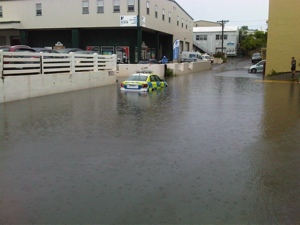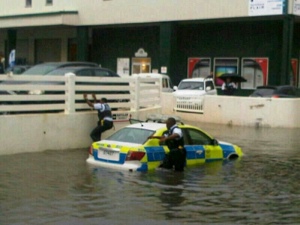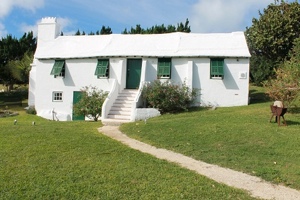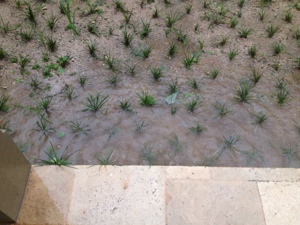This photo was forwarded to me from a friend, entitled “Hot Pursuit”
The news stated that an internal enquiry was under way – it looks pretty clear what they should conclude: police cars don’t float.
Yes, it has been raining – lots. September in fact had over 9 inches of rain, about 4 more than the expected average monthly precipitation. Maybe to compensate, we have had far fewer hurricanes and tropical storms than usual. Since I have spoken about the weather in a recent post (see Hurricanes) I have concentrated on water in this one.
Bermuda has no rivers, streams or lakes – no sources for surface freshwater. In UK the water industry draws from 650 reservoirs and 600 river abstraction points and to supplement that, about one third of the domestic water supply comes from boreholes and ground water.
The aeolian (wind blown) limestones that form the island of Bermuda are loosely cemented and extremely permeable and the soil cover is only 6 inches thick, so water does not collect on the surface. In addition the maximum elevation above sea level is about 30 metres so not designed for streams (or creaks if you are from USA). There are 5 groundwater lenses of brackish water, which are tapped to provide “non potable” water piped to about 15% homes and properties in the central parishes.
That leaves the rest of the island dependent on harvested rainwater. It is compulsory for every house to collect rainwater from the roof, mandated by the 1951 Public Health Regulations. This is the reason for the design of the white roof.
Carter House is thought to be the first building to have such a roof, built in 1640.
Limestone slates, 18 by 12 inches and about 1.5 inches thick are overlapped on a gently sloping frame and gutters are created across the roof from triangular stones, creating channels or “glides” that divert the water into vertical “leader” pipes down into a tank usually beneath the house. The whole roof is sealed and painted with a lime whitewash that helps keep water clean.
In most Bermuda homes the tank is in an excavation below the house, waterproofed concrete abutting the rock wall.
The size of the tank is an important selling point for properties, advertised prominently. Our home has a 41,000 gallon tank.
In UK we might be attracted by a double garage (pointless here where permitted only one car per household), in Bermuda it is the size of your water tank that matters!
The importance of the tank is reflected in the description given to heavy downpours: tank rain
One person on Bermuda uses approximately 30 gallons water per day
This is low compared to US where it is about 42 gallons and UK where it is 39 gallons.
It is probably down to historical need for conserving water. In the book I read when we first arrived, Tea with Tracey, she describes using washing up water in the garden and water collected from dehumidifiers to flush toilets – I confess I managed only one week of this, not a habit I found easy.
Is it safe to drink?
Well, it’s rainwater, but generated from marine air masses (the clouds form over the sea, in plain English)
This means it might have less organic nitrates in it compared with rain over larger land masses. In 2010 the Bermuda Government commissioned a survey into harvesting of rainwater but this did not cover the composition of the water – merely concluded that it was “safe”, seemingly on the basis that it had been done this way for over 350 years! (http://gov.bm ). On the government web pages about water conservation they do say it is “common practice” to disinfect the water with 1/4 cup of bleach for every 1000 gallons of water:
So in our case the tank would need over 200 bottles of bleach …. Surely not?
I think I will leave that to the landlord!
All the tourist sites state it is safe to drink – but they probably would.
I will filter it for you when you come to stay, just ask.
What happens if you run out or it doesn’t rain?
You won’t need to think about this in UK a this year, but here we are encouraged to conserve water:
Showers, not baths (my home has an enormous bath yet to be christened)
Buckets not hoses to clean the car (Offered in central car park for $30 – I hate washing cars)
Wash full laundry loads (that’s a bit hard when there are only two of you – so the sheets and towels are very clean)
If by any chance you do run out then for $180 you can have a tanker deliver 2000 gallons
And they do drive up the narrowest of lanes.
The environmentally aware reader will be asking “why not desalination”
This does happen on the island using a reverse osmosis process. The government licenses private water companies to produce about 3 million gallons of water daily in this way. Half of this comes from the brackish water lenses and the rest from shoreline wells. This is where the trucked water comes from. One friend has told me they need about 8 trucks of supplemental water each year – this is something to consider when renting, an older home may have a smaller tank or smaller catchment area on the roof and so you would need to pay for extra, perhaps amounting to over $1000. Forgive me if I smile like a Cheshire Cat as I think about our enormous tank 🙂
I shall conclude:
Water, water, every where, And all the boards did shrink; Water, water, every where! Nor any drop to drink.
The Rime of The Ancient Mariner
(From which I learnt “don’t shoot the albatross”)




